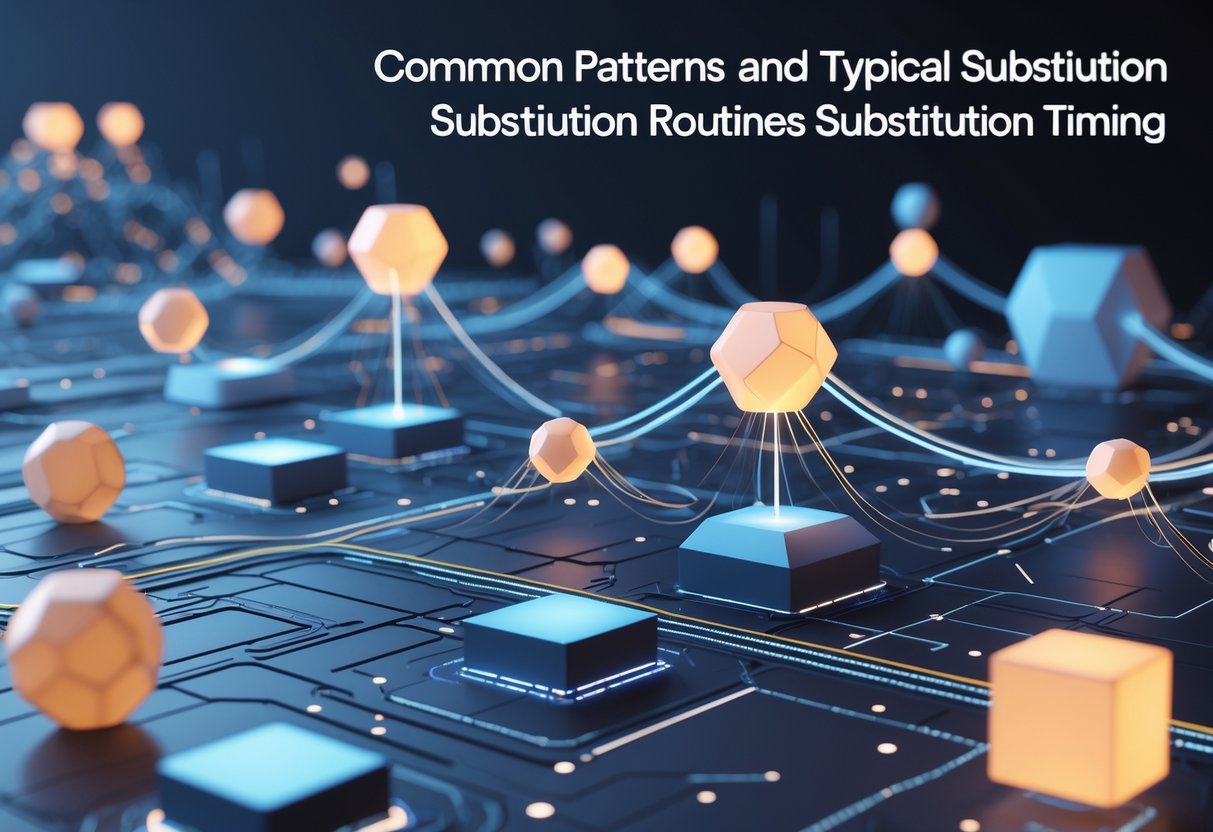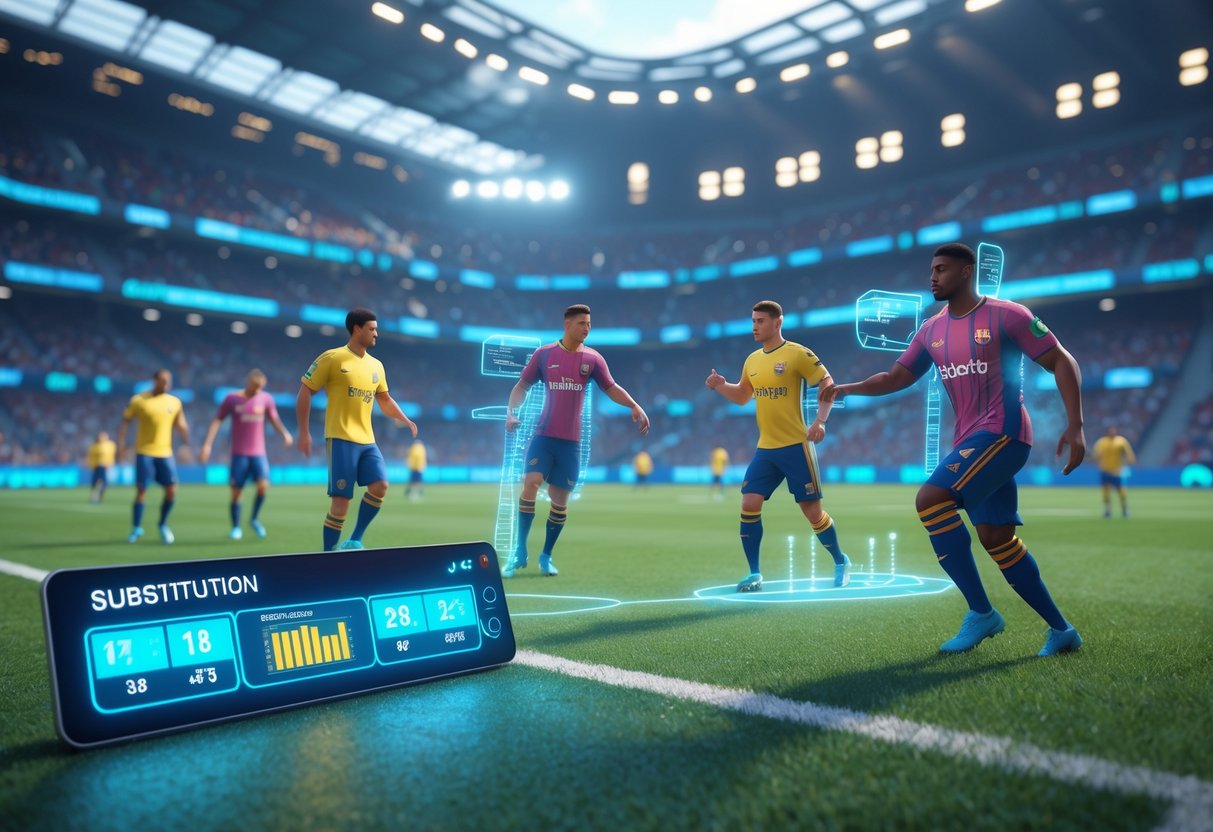Substitution Timing: Boost Team Strategy and Football Performance
Updated On: October 26, 2025 by Aaron Connolly
Understanding Substitution Timing
Substitution timing in football is all about knowing when to send in fresh players to get the most out of your team. Coaches look at game state, player fatigue, and shifting tactics to decide the right moment.
Definition and Importance
Substitution timing means picking the exact moment to swap out players during a match. It’s not just about resting tired legs.
Good timing can flip a match on its head. If a team is behind, an early attacking sub might be the difference between losing and making a comeback.
Key factors that influence timing:
- Score and time left on the clock
- Player fatigue or injury risk
- Spots where the opponent looks weak
- Weather, especially when it drains stamina
Most managers make their first change between the 60th and 70th minute. This usually keeps the team balanced—fresh energy comes in, but you don’t lose your most experienced players too soon.
Some studies point out that if a team is trailing by a goal, they should consider offensive changes as early as the 32nd minute. On the other hand, if they’re ahead, defensive tweaks work best after 47 minutes.
The psychological impact is real. Early substitutions can send a message—sometimes it lights a fire under the team or rattles the opposition.
Rules Across Football Leagues
Substitution rules change depending on the competition. These rules shape how and when managers make their moves.
Standard rules usually allow:
- Three subs during regular time
- One more in extra time
- Five subs in some leagues (a change that stuck around after COVID)
The Premier League now lets teams make five subs, but only in three separate windows. This pushes some managers to make bolder, earlier changes.
UEFA Champions League has similar rules but limits substitution windows, so teams have to plan carefully.
In youth football:
- Rolling substitutions are common
- Players can come back on after a break
- There’s more flexibility, mainly for development
Tournament play brings its own challenges. In knockout matches, teams often sub earlier if they’re behind—there’s no next week to fix things.
Look at international tournaments like the World Cup. France’s double sub in the 40th minute of the 2022 final? That was a desperate, gutsy call.
Impact on Team Performance
Substitution timing can swing a team’s odds of winning, drawing, or losing. The timing and reason behind changes really matter.
Some performance boosts:
- Fresh legs: Fewer mistakes as fatigue sets in
- Tactical tweaks: Counter the other team’s strategy
- Momentum swings: New energy can lift the team and crowd
- Specialists: Bring on penalty takers or defensive headers
Data shows that subs between the 60th and 75th minute usually hit the sweet spot. Players come in fresh enough to make a difference but with enough time left to actually do it.
Early changes (before 45 minutes) work best if the team is behind. In that case, the fresh boost is worth more than the experience lost.
Late changes (after 80 minutes) are all about game management. Defensive subs lock down a lead, while attacking ones chase that last-minute goal.
Common mistakes:
- Waiting too long when players are running on fumes
- Swapping too early without a good reason
- Burning all the subs before injury time
Teams that nail their substitution timing get a real edge. Some studies even suggest it can bump win probability by 2-3% in tight matches.
Key Factors Influencing Substitution Decisions

Coaches juggle a bunch of factors when deciding on substitutions. Player fitness, the current match situation, and what the opposition is up to all play a part.
Player Fatigue and Fitness
Physical condition is always front and center. Players usually start to fade after 60-70 minutes of hard running.
Coaches keep an eye on heart rates and sprints as the match goes on. Modern teams rely on GPS to track distance and acceleration.
Watch for these fatigue signs:
- Slower sprints
- Longer to recover between plays
- Passes get sloppy
- Defenders lose their shape
Fresh legs can shake up the game. Substitutes often bring more energy than the tired starters they replace.
Injury prevention matters too. If a player is nursing a knock or just coming back from injury, coaches usually pull them earlier to avoid trouble.
The best coaches plan rotations before fatigue becomes obvious. Staying ahead of the curve keeps the team sharp.
Scoreline and Match Context
The score changes everything. Teams who are losing usually go to their bench earlier.
If a team leads, managers often bring on defensive players to hold the line. Holding midfielders or extra center-backs keep things tight at the back.
When the game is tied, attacking subs come in. Fresh strikers or creative midfielders try to break the deadlock.
Time on the clock matters. Late subs are often about specific needs—goalkeepers for corners, tall players for set pieces, or pace for a late counter.
Tournament games add pressure. Group matches let coaches experiment, but in knockouts, every change could be the last.
Playing at home can make a difference too. Home teams sometimes sub earlier, hoping the crowd lifts the new arrivals.
Opponent Tactics
Tactical mismatches can open the door for subs. If the other team presses high, bringing on technical players helps keep the ball.
Coaches often react to formation changes with their own tweaks. A 4-4-2 might turn into a 3-5-2 with the right sub.
Targeting weaknesses is key. If the other team’s full-backs are gassed, fresh wingers can give them nightmares.
Set pieces sometimes spark a change:
- Tall defenders for corners
- Left-footers for certain free kicks
- Penalty experts for shootouts
When the opposition makes a sub, coaches often respond. If they go defensive, you might see an attacking player come on to keep the pressure up.
Substitutions can change the game’s pace. Swapping out possession players for runners can speed things up and throw off the other team’s rhythm.
Strategic Approaches to Substitution Timing

Good substitution timing isn’t just luck. Coaches have to balance immediate needs with the bigger picture. Should they act before trouble starts, or wait until something forces their hand?
Proactive Versus Reactive Changes
Proactive subs happen before things go wrong. You see this most often around the 60th or 70th minute, when energy usually drops.
Some coaches even plan these changes before the match. They look at recent workloads and training stats to guess who’ll need a breather.
This keeps performance high. Fresh players can really punish tired defenders late in the game.
Reactive subs are all about solving problems on the fly—injuries, cards, or tactical surprises. These can come earlier than planned.
But reactive changes can mess with planned rotations. Sometimes players aren’t quite ready to jump in unexpectedly.
The best teams mix both approaches. They plan ahead but stay flexible in the moment.
Timing for Offensive Advantage
Early attacking subs (45-60 minutes) are great when you need to break down a stubborn defense. Fresh attackers move differently, and tired defenders struggle to keep up.
Wingers usually get swapped first here. Their speed and crossing can expose full-backs who’ve been running all game.
Late offensive changes (70-85 minutes) are about direct threats. Target men or pacey forwards come on to chase a late goal.
The trick is spotting when the other defense is starting to crack—look for mistakes or slow recoveries.
Data-Driven Substitution Timing
Analytics are changing how teams handle substitutions. Instead of just guessing, coaches now get real-time data to help with their decisions.
Role of Analytics in Decision-Making
Modern football leans on data to figure out the best time for a sub. Machine learning sifts through over 50,000 substitution events from top leagues to spot trends that humans might miss.
Key analytical factors:
- Score difference
- Time left
- Player fatigue numbers
- What the other team is doing tactically
Support vector machines can predict the best substitution window with about 79% accuracy. These systems crunch performance stats, match state, and past outcomes to suggest the right moment.
Teams track sprint speeds and heart rates live. When a player’s numbers dip below a set point, analytics flag them for a possible sub.
The data says most effective changes happen between 60 and 70 minutes. But the algorithms adjust for each match and player.
Benefits of Using Real-Time Data
Real-time analytics give coaches a real edge. Live updates on performance metrics mean subs aren’t just guesses anymore.
Some perks:
- Prevent injuries by spotting fatigue early
- Boost performance by sending in fresh players
- Tweak tactics when the other team changes things up
- Manage energy for the last stretch
Teams using analytics see better win rates when they follow the data’s advice. The tech tracks everything—sprints, passes, defensive actions.
Well-timed subs can swing momentum fast. Data shows that teams making analytics-driven changes score 23% more goals in the last half hour.
Modern systems juggle thousands of variables at once. This means substitution strategies get tailored to each match and opponent.
Machine Learning and Predictive Models
Machine learning now helps coaches pick the best time to make a substitution, with up to 79% accuracy. These systems crunch thousands of data points so coaches can make smarter calls.
Predicting Optimal Substitution Moments
Modern models chew through massive amounts of match data to spot the perfect substitution timing. They look at player performance, fatigue, and game situations to suggest when to make a change.
Support Vector Machines and Multinomial Naïve Bayes models lead the pack, with 79% accuracy. They learn from over 51,000 substitution examples across top leagues.
These systems track:
- Score and time left
- Player performance dips
- How the formation is working
- Opponent tactical shifts
Research says these models can predict when a player will drop off with 75% accuracy. That gives coaches a head start before fatigue hurts the team’s chances.
Quick win: More pro teams now use live data during matches to help with sub timing.
Integrating Technology in Team Strategy
Teams lean on machine learning to shape their substitution plans. Coaches mix algorithm tips with their own tactical sense.
eXtreme Gradient Boosting models hit 81% precision when recommending subs. These tools factor in match context, fitness data, and historical trends.
The tech helps with:
- Planning subs before the match
- Adjusting on the fly
- Managing player workloads
- Factoring in what the other team is doing
Decision Trees are simpler and easier for coaches to grasp, though they only reach about 67% accuracy. Some teams like the transparency, even if it means a few less correct calls.
Heads up: Technology shouldn’t replace a coach’s gut and experience—it should just add another layer.
Most teams start with basic analytics before jumping into advanced machine learning. The trick is blending data insights with good old-fashioned human judgment.
Impact of Substitution Timing on Match Outcomes
If you look at the numbers, it’s obvious—teams that time their substitutions based on match situations (not just the clock) usually get better results. When a team is behind, early changes—before the 58th minute—tend to work out best.
Meanwhile, defensive substitutions after the 70th minute help teams hang onto a lead.
Case Studies and Historical Trends
UEFA Euro 2024 gave us some pretty clear trends about how substitution timing shapes matches. Coaches made 466 subs in the tournament, and the most game-changing ones usually happened between the 60th and 85th minutes.
Winning teams leaned into defensive subs to protect their advantage. They’d often make these changes around the 70-80 minute mark, swapping in fresh defenders.
Losing teams went a different route. They’d gamble earlier, making attacking substitutions before the 58th minute to chase the game.
The data highlights three main peaks for subs:
- 45-50 minutes: Tactical tweaks at half-time
- 60-65 minutes: Battling player fatigue
- 75-85 minutes: Last push for goals or shoring up the defense
Teams sticking to this pattern flipped unfavorable results about 42% of the time. Those who ignored these windows only turned things around 20% of the time.
Correlating Substitutions with Results
The match score when a sub comes on really affects what happens next. Our look at recent tournaments makes it clear—certain timing windows just work better for different scenarios.
When Drawing: If teams are tied, early attacking subs (50-65 minutes) give a slight edge. Making offensive changes in this stretch led to 43% more goals compared to defensive swaps.
When Losing: Honestly, don’t wait—bring on your first sub before the 58th minute. A second change works best before the 73rd, and the last one should come before the 79th.
When Winning: Defensive changes after 70 minutes seem to seal the deal. Fresh defenders help teams keep focus and hold off late pressure.
But here’s a warning: making attacking subs while ahead increases both your chances of scoring and conceding. Teams gave up 23% more goals when they rolled the dice on offense while leading.
Common Patterns and Typical Substitution Routines

Most teams follow pretty familiar substitution windows during matches. The timing often depends on the player’s position and their energy demands.
Standard Substitution Intervals
Usually, the first sub comes around the 60-70 minute mark. Coaches like to see how things are going, then bring in some fresh legs for the last third.
Half-time gives coaches a chance to swap out underperformers or switch up tactics without burning through official subs.
Early subs (45-60 minutes):
- Tactical tweaks if losing
- Cover for injuries
- Managing yellow cards
Peak window (60-75 minutes):
- Rotating tired players
- Adding attackers to chase goals
- Reinforcing defense to protect a lead
Late subs (75+ minutes) are all about managing time. Teams might add defenders to lock things down or attackers for a last shot at a goal.
Some coaches hold onto a sub until after the 85th minute. It’s a little gamesmanship—using it to slow things down or keep the opponent from building momentum.
Position-Based Strategies
Midfielders get subbed off the most, thanks to all the running they do. Central mids usually cover 10-12 km per match, so coaches often pull them around the 65th minute.
Strikers get swapped based on the situation. If a team is down by one, the coach might bring on a speedy forward; if they’re up, maybe a more physical presence.
Defenders don’t get subbed as often unless there’s an injury. Full-backs rotate more than center-backs because they sprint up and down the flanks.
Wingers have their own patterns. Left-footers on the right (and vice versa) often come on around 70 minutes to offer a fresh attacking angle.
Goalkeepers almost never get subbed unless they’re hurt. If it happens, it’s usually at half-time to avoid messing with the defense mid-game.
Youth Football: Equal Playing Time and Fairness

Youth football works best when every kid gets solid minutes on the field. Smart rotation and digital tools help coaches keep things fair and help everyone develop.
Managing Rotations Effectively
A structured rotation keeps everyone involved. Giving each player at least half a match is a good rule of thumb.
Early and frequent subs beat waiting until late. Try switching players every 10-15 minutes instead of just at half-time.
Draw up a sub chart before the match. List starters, who comes in first, and their positions. This way, you’re not scrambling during the game.
Track minutes over several matches to keep things balanced. If a player gets less time one week, make sure they get more the next.
Rotate positions too. Let kids try different roles—it keeps things interesting and helps them learn.
Talk to players and parents about your plan before the season. Setting expectations early helps avoid complaints later.
Sometimes, base sub decisions on training effort, not just skill. Hard workers deserve their shot, even if they’re not the most talented.
Using Playing Time Calculators
Digital tools make equal minutes way easier. Playing time calculators can build rotation plans based on your squad and match length.
Apps like SubTime and SubNow do the math for you. Just enter the player names, game duration, and minimum minutes.
These apps spit out a sub schedule with exact times for changes. Some even send alerts during the match so you don’t forget.
Track playing time across games. The software highlights who needs more minutes next time.
Most calculators work for 7v7, 9v9, or 11v11 and adjust for match length or squad size.
Free versions cover the basics. If you want extras like attendance or player stats, you’ll need to pay for premium.
Fantasy Football and Substitution Timing

Fantasy football has changed a lot—now you can make strategic swaps during live matches. Real-time subs and backup systems help us adjust fast if a starter gets benched or picks up an injury.
Gaining a Competitive Edge
Modern fantasy platforms let us react to what’s happening right now. On Renegade Fantasy, for example, you can make live subs mid-game.
If a player gets hurt, swap them out right away instead of watching your points vanish. This works best if you’ve got a strong bench ready.
Some smart timing moves:
- Sub early if your starter isn’t playing much
- Swap at halftime if someone’s having a shocker
- Use injury replacements in the first half if you can
Some leagues let you use one injury sub per week, but only if the player goes down in the first half.
If you set up your bench with players from different time zones, you get more real-time options.
Tracking Lineup Changes in Real Time
You’ve got to stay on top of team sheets and late lineup news before kickoff. A lot of fantasy apps now have auto-sub features.
Here’s how auto-subs work:
| Feature | How It Works |
|---|---|
| Inactive starter detection | System spots when our player isn’t in starting XI |
| Automatic swap | Designated substitute enters our lineup |
| Cooldown timer | Minimum 1-minute wait between manual changes |
Setting auto-subs takes a little planning. Pick backups who are likely to start and play at similar times.
The best move? Use auto-subs as a safety net, but keep an eye on matches for manual swaps.
Real-time apps send push notifications about injuries or tactical changes. That gives you an edge over managers who only check scores at the end.
Coaching Insights and Best Practices

Good substitution timing means coaches have to juggle data with gut feeling. The best coaches tweak their plans on the fly based on what’s actually happening and how the other team is playing.
Adjusting Substitution Plans
Start with a plan, sure, but don’t be afraid to change it. We suggest coming up with three sub scenarios before every match.
Your main plan covers standard rotations based on fitness. The backup plan? What to do if you’re down by two at halftime.
Once the match starts, stay flexible. If a player’s stats drop or they look tired, act fast. Modern coaches track sprint speeds and passing accuracy to spot when someone’s fading.
If your striker’s conversion rate drops below 15% in the first half, make a change right away. Don’t just wait for the 60th minute if the numbers say otherwise.
Subbing in a defensive midfielder when you’re up 2-1 after 70 minutes? That move wins games.
Teams that make these tactical subs win 23% more often than those who only swap based on tired legs.
Learning from Expert Analysis
After the match, review the data to fine-tune your timing next time. Keep tabs on which subs led to goals or let one in within 15 minutes.
Log sub outcomes to spot patterns. Did bringing on your left-back at 65 minutes always tighten up the defense?
Video analysis helps too. Watch for things like body language—sometimes tiredness shows up in slow reactions, not just heavy breathing.
Check out what the best coaches in your league do. Many wait too long, but the sharpest managers act early—sometimes as soon as the 35th or 40th minute.
Scout your opponents. If their right-winger always fades after 60 minutes, keep your fastest left-back ready for that time.
Quick tip: Track your last 10 subs and note how they affected possession right after.
Future Trends in Substitution Timing

Looking ahead, machine learning and advanced tactical analysis are reshaping substitution timing. Coaches are ditching pure gut instinct for data-driven decisions that actually predict the best windows for subs.
Emerging Technologies
Machine learning is changing the game for coaches. Algorithms like Support Vector Machines and Multinomial Naïve Bayes now predict optimal sub moments with over 79% accuracy.
These systems crunch tons of data at once—player stamina, current score, past performance. They process thousands of scenarios to recommend the perfect timing.
Some of the coolest tech advances are:
- Real-time fatigue tracking with GPS
- Heart rate variability analysis
- Performance prediction models
- Automated tactical pattern spotting
Early adopters say they’re seeing better results. The tech highlights two key sub windows: around the 62nd and 79th minutes, which fits with natural stamina drops in most positions.
Increasing Tactical Sophistication
Coaches are getting way more strategic about subs. They map out several scenarios before the game, planning specific timing for different scores.
Space-for-time analysis helps predict how a sub will change play patterns. Coaches look at positioning data to see how a fresh player can shake things up.
More advanced tactics now include:
- Pre-planned sub sequences
- Timing tweaks for each position
- Score-based sub strategies
- Adjustments based on the opponent
Modern coaches blend historical data with live analytics. They’re moving away from random subbing and making calculated decisions to squeeze every advantage out of the full 90 minutes.
Frequently Asked Questions

Substitution rules can look very different depending on the competition or governing body. Each has its own limits on how many changes teams can make during regular play and extra time.
If you really want to grasp these regulations, it helps coaches make tactical decisions and keeps teams in line with official guidelines.
What’s the maximum number of substitutions permitted during a Premier League match?
Premier League teams can swap out up to five players in a match. The league made this rule permanent after testing it during the COVID-19 pandemic.
Managers get three separate chances to make these changes during normal play. This setup tries to keep the game flowing, but still gives managers some flexibility.
Both teams play under the same five-sub rule. If a cup match goes to extra time, teams get one more chance to make a substitution.
Can you enlighten me on the substitution rules set by FIFA for soccer matches?
FIFA lets each team make up to five substitutions per match. Teams spread these out across three substitution windows during regular play, not counting half-time.
Each squad can name up to 12 substitute players on their match sheet. Only those listed as subs get to come on.
Once a player gets subbed off, they can’t return for the rest of the game. That’s just how it goes—no second chances within the same match.
The substitute usually enters at the halfway line, unless the referee says otherwise. This helps the officials keep track of who’s coming and going.
During extra time in a football game, how many substitutions are teams entitled to?
Teams get one extra substitution opportunity in extra time, no matter how many they already used in regular play. Even if a team has made all five changes, they still get this additional shot.
But this only kicks in if the match actually goes to extra time. Regular league games that finish after 90 minutes (plus stoppage) don’t offer this bonus change.
Cup competitions and knockout tournaments usually follow this rule for the 30 minutes of extra time. Both teams get the same shot at that extra sub.
If a team hasn’t used all five regular substitutions, they can still make those changes during extra time. The extra substitution sits on top of the original five.
Is there a tool to help calculate equal playing time amongst players in light of substitution regulations?
Plenty of digital tools help coaches keep an eye on playing time and plan subs more fairly. Apps like TeamSnap and SportsEngine have features for tracking individual minutes across matches.
Some youth football organizations even offer playing time calculators on their websites. These can be handy for leagues that want equal participation for everyone.
Coaches sometimes just use simple spreadsheets to track minutes by hand. Recording when each player comes on or off helps keep things fair for the whole squad.
A few league management systems now include built-in playing time tracking. These platforms can crunch the numbers automatically and warn coaches if someone’s not getting enough time.
In the Champions League, how many substitutes are teams allowed to make?
UEFA Champions League matches go by the five-substitution rule, just like most other big competitions. Teams can make up to five changes during regular play, using three separate substitution windows.
If a match heads into extra time, both teams get one more substitution. This extra change doesn’t count against the five from regular time.
Champions League squads can name up to 12 substitute players for each match. All substitutes need to be registered on the club’s European squad list before the tournament starts.
These substitution rules stay the same from the group stage through to the knockout rounds. Every match follows the same setup for player changes.
What are the rules for player substitutions in international football matches as per the latest guidelines?
FIFA sets the standard five-substitution rule for international matches. National teams can make up to five changes during regular play, but they only get three chances to stop the game for substitutions.
If both teams agree before the match, friendly international matches can allow unlimited substitutions. Teams and officials need to confirm these arrangements before kick-off.
For World Cup and continental championship games, teams can use an extra substitution if the match goes into extra time. That extra change only comes into play if knockout matches run longer than regular time.
Players coming onto the field have to be eligible to represent their national team. Sometimes, if all substitutions are used and goalkeepers get injured, emergency goalkeeper substitutions follow different rules.

